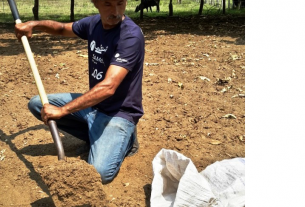By Dan and Lisa Goy from the January 2019 Edition
March 24 – 27, 2016 (Days 78-81)
Jocotepec, Jalisco
We got a good start on Thursday, March 24, as we headed for Guadalajara and our destination at the Roca Azul Resort and RV Park in Jocotepec, both located in Jalisco. This was the Easter weekend and Mexicans were on the road, en masse. Easter (Semana Santa) is the most important holiday in Mexico, without question. Roland and Janice led as we navigated our group through metropolitan Guadalajara and more traffic than we had seen on our 90-day tour to date. This seemed longer than usual, because of the traffic, and we were thankful to finally arrive at our destination, Roca Azul, on the shore of Lago (Lake) Chapala, about 50 KM south of Guadalajara.
We were scheduled to be here for 4 nights in total and collectively decided to take a pass on Guadalajara. Honestly, we are all tired and the Easter weekend was upon us. We will visit Guadalajara another time. Easter in Mexico is always busy and loud, not so much at Roca Azul which was very busy and full but actually the guests were relatively restrained. Rafael Acevedo’s family has owned the property for decades and had developed a terrific resort with all the bells and whistles, including a huge pool.
Had we wanted to head in Guadalajara, the resort has a van and driver/guide that offer that service a very reasonable rate. Spending Easter with Mexicans is great…so much enthusiasm for life, with lots going on with families.

On the road at Easter
The day after our arrival we went into the local town of Jocotepec, looked around the Mercado, found a bank, visited the Malecón and had lunch. The next day, we dropped over to Chapala, the biggest community around Lago Chapala. There were lots of activities, markets and shops open everywhere, as Mexicans were celebrating the holidays. We had a good walkabout and left around noon, which was good as there was much more traffic already.
Chapala itself is a cool place to visit, located on the north shore of Lake Chapala, Mexico’s largest freshwater lake. Since the 1960s, Chapala has been frequented by both Mexican and international tourists and has a large expat population, many permanently there with an average year round temperature at 25C or 76F. Among the area’s cultural attractions is mariachi music, which originated in the state of Jalisco.

While many fine mariachi bands have been based in Chapala, the more famous groups are based in larger cities nearby. The most famous mariachi in Mexico is Mariachi Vargas de Tecalitlán, founded in the late 19th century in the southern Jalisco

Dan with Rafael and Jesús
city of Tecalitlán, but now based in Mexico City. We attended a concert they played in Vancouver a couple of years ago. What a performance!
Later we had a potluck for dinner and played Mexican Train. Janice, the novice,
was the winner, sometimes it happens that way. Our last day, on Easter Sunday,
brunch was hosted by Roland and Janice, which was tasty, for sure. Later, the
gang hit the pool. No more excursions were planned. By the afternoon, lots of
Mexican families had left and the campground was Did you know?
Lake Chapala (Lago de Chapala) is Mexico’s largest freshwater lake. It lies in the municipalities of Chapala, Jocotepec, Poncitlán, and Jamay, in Jalisco, and in Venustiano Carranza and Cojumatlán de Régules, in Michoacán.
Chapala public art
Geographic features
It is located at 20°20′N 103°00′W, 45 km southeast of Guadalajara, Jalisco, and is situated on the border between the states of Jalisco and Michoacán, at 1,524 metres (5000 feet) above sea level. Its approximate dimensions are 80 km (50 mi) from east to west and averages 12.5 km (7.8 miles) from north to south Islands
The lake also contains three small islands, Isla de los Alacranes (most visible from the town of Chapala,) Isla Mezcala (the largest island featuring and old Spanish fort and an old Mexican prison), and a third very small island next to Isla Mezcala called La Isla Menor.
Ecology
The city of Guadalajara has relied on Lake Chapala as a
principal source of water since the 1950s. Shortly after, a few consec
that had been hidden for many years. Its fast decay has raised concern in the
surrounding areas and in the scientific community. It was the Global Nature
Fund’s “Threatened Lake of the Year” in 2004. By 2007 and 2008, the
level of Lake Chapala increased drastically, though the levels have yet to
surpass the level in 1979, when they began a precipitous decline.
Although it is still subject to agricultural, domestic, and industrial sources of contamination, the actual levels of hazardous materials has not been officially assessed with regularity.
Chapala Centro
Although water level and quality improved due to water treatment plants along the Lerma river, in 2017 the water quality of Lake Chapala water was assessed as a risk to public health. In 2018, the Lake Chapala water level is at 81.68% of capacity, up from 66.66% in 2017.
Habitat and species
Great egret at Chapala Lake – The lake is a critical habitat for several species of migratory birds, such as the American white pelican, and is home to thousands of indigenous plants and animals. The Audubonistas de Laguna de Chapala holds an annual Audubon Society-sponsored Christmas Bird Count. In 2006, some 117 species were identified and, in 2007, the count was 125. By January 2011, some 173 species were recorded.
The subspecies chapalaense of the rough-footed mud turtle is largely restricted to Lake Chapala, while the more widespread subspecies murrayi inhabits the Lerma River basin (and some other regions in northern Mexico). The essentially harmless, semi-aquatic obscurus subspecies, Mexican garter snake, is restricted to the lake.
In addition to the Chirostoma (“charales”) species flock of fish, the lake and associated rivers are home to many other endemics, including several goodeids, a few Algansea chubs, two Tetrapleurodon lampreys, two Ictalurus catfish, the Chapala chub (Yuriria chapalae) and more. Several of these are highly threatened. Other aquatic species found only in the lake and associated water systems are four cambarid crayfish: Cambarellus chapalanus, C. lermensis, C. prolixus and Procambarus digueti.
Lake Chapala fowl
Communities
There are numerous towns and cities along the coast of Lake Chapala, including Chapala, Ajijic, San Antonio Tlayacapan, Jocotepec, San Juan Cosala, Mezcala de la Asunción, Tizapán El Alto, La Palma, Michoacán and Ocotlán. Beginning in the 1950s, due to the pleasant climate and attractive scenery, a substantial colony of retirees, including many from the United States and Canada, has been established along the lake’s shore, particularly in the town of Ajijic, located just west of the city of Chapala.
The full edition or view it online
Dan and Lisa Goy, owners of Baja Amigos RV Caravan Tours, have been making Mexico their second home for more than 30 years and love to introduce Mexico to newcomers.




